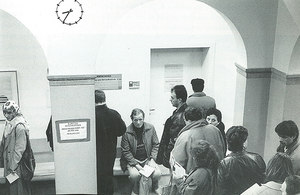
Unternavigation
Unemployment Funds
The first unemployment funds were mainly set up by emerging trade unions.The federal act of 1924 granted them subsidies in order to safeguard their economic survival and develop public paritary unemployment funds. The introduction of compulsory insurance in 1976 brought a lasting change to the role of unemployment funds.
Although a number of state initiatives had been taken in the cities of Bern, St. Gallen, Zurich and Basel by the end of the 19th century, the first unemployment funds were founded chiefly by trade unions. These funds sought to support union members, relieve pressure on wages and acquire new members. The unions affiliated with the Swiss Federation of Trade Unions (SGB) since 1880 as well as the leaders of Christian trade unions, the Swiss Catholic People’s Party with close ties to the later Christian Democratic People’s Party, were committed to the mutual assistance of workers and called for federal subsidies, which were then introduced in 1924. The insurance scheme was voluntary. Employees who satisfied the statutory conditions were able to join a fund. The fund was also responsible for the disbursement of benefits and for examining whether the affected policyholders were really unemployed without any fault of their own.
In 1924, less than ten per cent of the working population was insured, 94 per cent of which by trade union funds. The funds provided by the Swiss metal and watch workers’ union (SMUV) and the Swiss construction and wood workers’ union (SBHV) alone accounted respectively for 20 per cent and ten per cent of all policyholders.
Federal subsidies and the increase in unemployment during the economic crisis of the 1930s resulted in the creation of public paritary funds. Managed and funded by employers, employees' contributions and federal subsidies, these funds presented a relief on the welfare burden for the municipalities and cantons (poverty). Employers, particularly in the clothing, textile and shoe industry, were likewise interested in organizing their own funds as a means of retaining workers and limiting trade union admissions. Since the public paritary funds mainly emerged in sectors dominated women workers (textile and watchmaking industries), they helped raise the number of insured women, who remained underrepresented in trade union funds. In contrast to trade unions’ funds, the public funds had to accept everyone who fulfilled the statutory terms of insurance (it was not possible to exclude people whom insurers deemed to be ‘bad risks’). From 1933, the number of women insured in public funds was higher than the number in trade union funds.
In the period between the crises of the 1930s and the 1960s, just under half of the people insured were members of trade union funds, while public sector funds accounted for around a third and the paritary funds a fifth. Although the number of policyholders remained relatively stable (at around half a million throughout the entire period), the share of the working population with insurance fell sharply, dropping from 25 per cent to 16 per cent between 1945 and the end of the 1960s. The economic crisis of the 1970s (1975–1979) brought about a rise in new admissions to funds, and by then almost all workers were insured against unemployment due to the introduction of compulsory insurance in 1976.
The federal decree of 8th October 1976 and the Federal Act on Compulsory Unemployment Insurance and Insolvency Compensation of 25th June 1982 also changed how the insurance was organized and managed. The (public sector, trade union or paritary) funds no longer had their own members; employees now had to register with a fund when they wanted to assert a claim for unemployment compensation. Funding was also standardized and centralized. The contributions were now deducted directly from wages and the necessary financial resources were distributed to the funds for the compensation and administration costs. Monitoring duties were likewise centralized within the communal and cantonal administrations, particularly by the regional job centres (RAV) set up in 1995. Job placements, as well as assessing the suitability and availability of the unemployed were now tasks handled by RAVs. The unemployment funds continue to be responsible for certain sanctions, particularly when a person is unemployed ‘of their own accord’ (such as due to voluntary termination). The sanction in this case may involve the suspension of benefits for up to three months.
Literatur / Bibliographie / Bibliografia / References: Tabin Jean-Pierre, Togni Carola (2013), L’assurance chômage en Suisse. Une sociohistoire (1924-1982), Lausanne; Togni Carola (2013), Le genre du chômage. Assurance chômage et division sexuée du travail en suisse (1924-1982), Thèse de doctorat, Université de Berne.
(12/2014)




